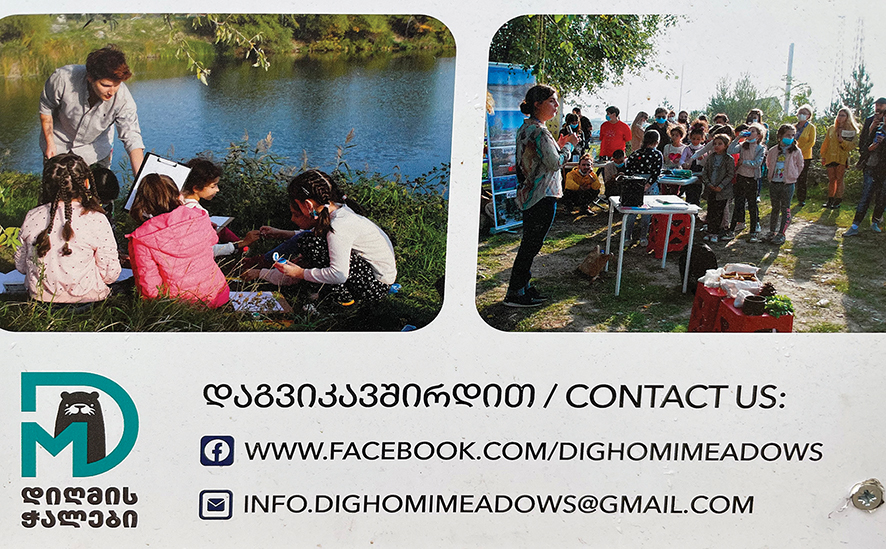Having spent a whole autumn and winter getting to know and photograph the neighborhood around our apartment, it was my great joy to discover recently a new sign put up near one of the ponds. “Dighomi Meadows,” it proclaimed, the whole notice board in both Georgian and English. It described the area’s wildlife (otters! Eurasian hoopoes! and more), some issues such as illegal dumping of garbage, and so on. There is a new Facebook group for the organization, https://www.facebook.com/Dighomimeadows as well. Today, I interviewed Ana Trapaidze about all this, on site.

Ana and her family, recently relocated from living and working abroad for a while, were stuck in the rising pandemic from late 2019. Living in the same building as my wife and I would later move to, they heard incessant trucks driving to and fro, and had to breathe in the dust of that movement night after night- this at a time when nighttime quarantines were supposed to be in effect. Ana began lobbying the city government to find out more, and discovered that there was an illegal gravel-digging operation going on between Green Diamond and the Mtkvari River, the holes being filled with construction waste. After hard protest work and videoing of the culprits, they were able to have this stopped (more or less). But there are still hectares and hectares of dumped concrete, rubble and more in this location.


The main island on the Mtkvari running under the bridge between Dighomi and Gldani is called Otter Island, for obvious reasons. Here, river otters can raise young entirely away from predatory dogs and cats. The whole area between the river and the sports complexes is a catchment zone for occasional flooding; anywhere you dig, your hole will fill up with water, slowly but surely.



We continued our walk behind the sports fields, and here Ana showed me many more ponds, artificial ones caused by gravel digging. She pointed out the sound of a kingfisher, which if I want to photograph I’ll need a much longer lens than my current maximum of 300mm. I had seen a woodpecker earlier, and also terrapins sunning themselves on logs, and snails. There’s plenty of wildlife, once you start looking for it. There must be fish in the main ponds, too, given the numbers of fishermen now coming out to try their luck, including an Orthodox priest.


We also found many new 20kg sacks of building waste dumped at the edge of one of the ponds; and Ana told me that she has caught youngsters after sports practice dumping drink bottles here too. Sheer laziness and lack of will to take the trouble to find proper garbage disposal locations.
My wife and I hope to be on hand for the next garbage removal day, before we go to Svaneti for the summer, to do what we can to clean up. It might be a small effort, but if more of us get involved, we can make a difference.
One of the things I have cherished about our new apartment is exactly this: its proximity to these ponds, the forests and the river. We have the best of both worlds: city and nature. I have spent many happy hours over many days shooting reflections in the ponds, closeups of rare ice in puddles in the winter, the changes of season and more; getting shots I can call some of my best recent work. I CAN shoot around the garbage. But it’s harming both the esthetic and the environment; and I can also remove it and promote proper garbage disposal. I hope to see things turn around and flourish here. Ana, thank you so much for your dedication as an eco-warrior!

Blog by Tony Hanmer
Tony Hanmer has lived in Georgia since 1999, in Svaneti since 2007, and been a weekly writer and photographer for GT since early 2011. He runs the “Svaneti Renaissance” Facebook group, now with over 2000 members, at www.facebook.com/groups/SvanetiRenaissance/
He and his wife also run their own guest house in Etseri: www.facebook.com/hanmer.house.svaneti














